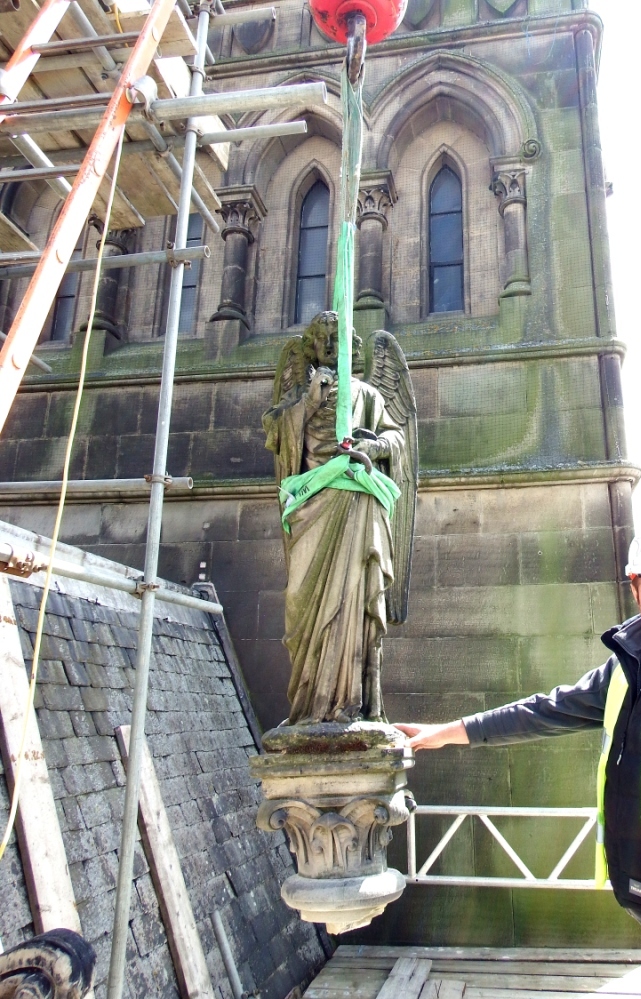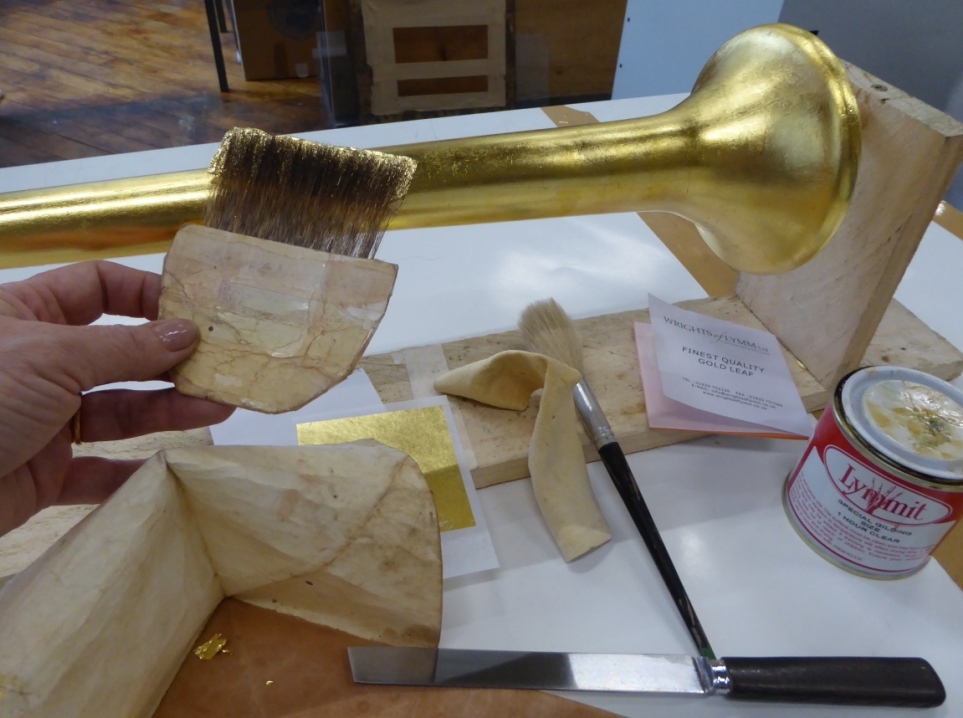We’re very privileged as a service to have a range of talented staff that work for us. Pam Keeton, who is part of our Collections team has written us a blog post about a recent project that that she was involved in, utilising some of her skills on a item at City Hall.
She writes:
It can’t have missed the attention of anyone visiting Bradford’s Centenary Square in the last year that most of City Hall has been hidden by scaffolding. High above our heads major renovations have been happening to repair and restore the 1873 face of the fine building designed by the architects Lockwood and Mawson.
Part of the renovations is the conservation and restoration of the ornamental masonry and the 35 statues depicting the Rulers of England that can be seen around the top of the building. The stonework has been cleaned, repaired and missing parts re-carved by a super skilled team of craftsmen whose work will take the building well into this century and beyond.
When an angel had just been reinstated after repair to the base, it was noticed that from the position of the arms and hands that there had once been a musical instrument held to the lips. Traditionally angels are associated with horns or trumpets to herald news or call to assemble.
A new trumpet was going to be commissioned and there was some discussion over the material and final finish. Ideally it would match the gilding on the clock face and tower but polished brass would tarnish and gold paint eventually fade.

It was a stroke of serendipity that Bradford Museum and Art Gallery conservation staff were on-site investigating the original paint scheme as part of the restoration and an overheard comment about a golden trumpet made my ears prick up
As a conservator I have experience of restoring and conserving gilded objects and it was a golden (!) opportunity to become involved.
Gilding is the application of very thin sheets of real gold leaf to a surface.
Gold is an amazing metal, it doesn’t corrode or change colour and thousands of years ago we discovered that because it’s so malleable it can be beaten into sheets so thin it’s almost transparent. It is prized for its beauty, valued for its rarity and used as a symbol of prestige and wealth.
Gold leaf comes in a range of colours, each carat having a subtly different shade depending on the quantity and blend of the alloying metal (usually silver and copper).It is sold in ‘books’ of 25 loose or transfer leaves with each leaf measuring 8cm square. Loose leaf is quite simply loose within the book and transfer leaf has been pressed onto a sheet of tissue to aid handling. One ounce of gold can produce about 80 books, with each leaf being in the region of a quarter of a millionth of an inch thick.
The body of the reproduced angels trumpet was cast from aluminium and polished to a smooth even finish. Because the trumpet is going to be outside and exposed to the elements it would have to be oil gilded for durability.
It was given two coats of primer and when this was dry it was sanded to a glass like finish and coated with an oil based gold size. When the size reached it’s ‘tack’ time – the point at which it is almost but not quite dry, the loose 23.5 carat, double weight gold was applied. Loose leaf was chosen for maximum shine and because the leaf is so thin and difficult to handle with bare hands a gilders cushion, knife and tip (flat natural hair brush) were used to apply it.

Once the entire surface was gilded it was allowed to completely dry and harden. As the gold will not tarnish or fade and the trumpet will not get worn or abraded from handling there is no need for any further surface lacquer or coating.

The trumpet was finally mounted in the angels hands on an appropriately golden Yorkshire day.

2 Responses
Hi
Back in 2003 I wrote a book about the City Hall statues – “Sovereign Statues of City Hall”
I am almost due to re-print the book and intend to add a little about the current re-furbishment. Do you have any photos of the work on the statues which I might be able to use?
Also, way back the former Print Unit had a good quality photo of the statue of Vistoria being erected at the front of City Hall surrounded by scaffolding and workmen. Do you happen to have a copy of that photo as I appear to have mis placed mine.
Finally (!) the Industrial Museum had a set of closeup photos of the statues taken in the early sixties. Do you know if they exist and whether I could see/scan copies of 3 of them – William 1, William 11 and Hemry 1 – for some reason these were not available at the time of me writing the book. (They are “round the left corner, eastern end of City Hall and may have been missed by the photographer)
Many thanks for your help
John
Hi John, we’ll drop you an email with some information regarding your queries.